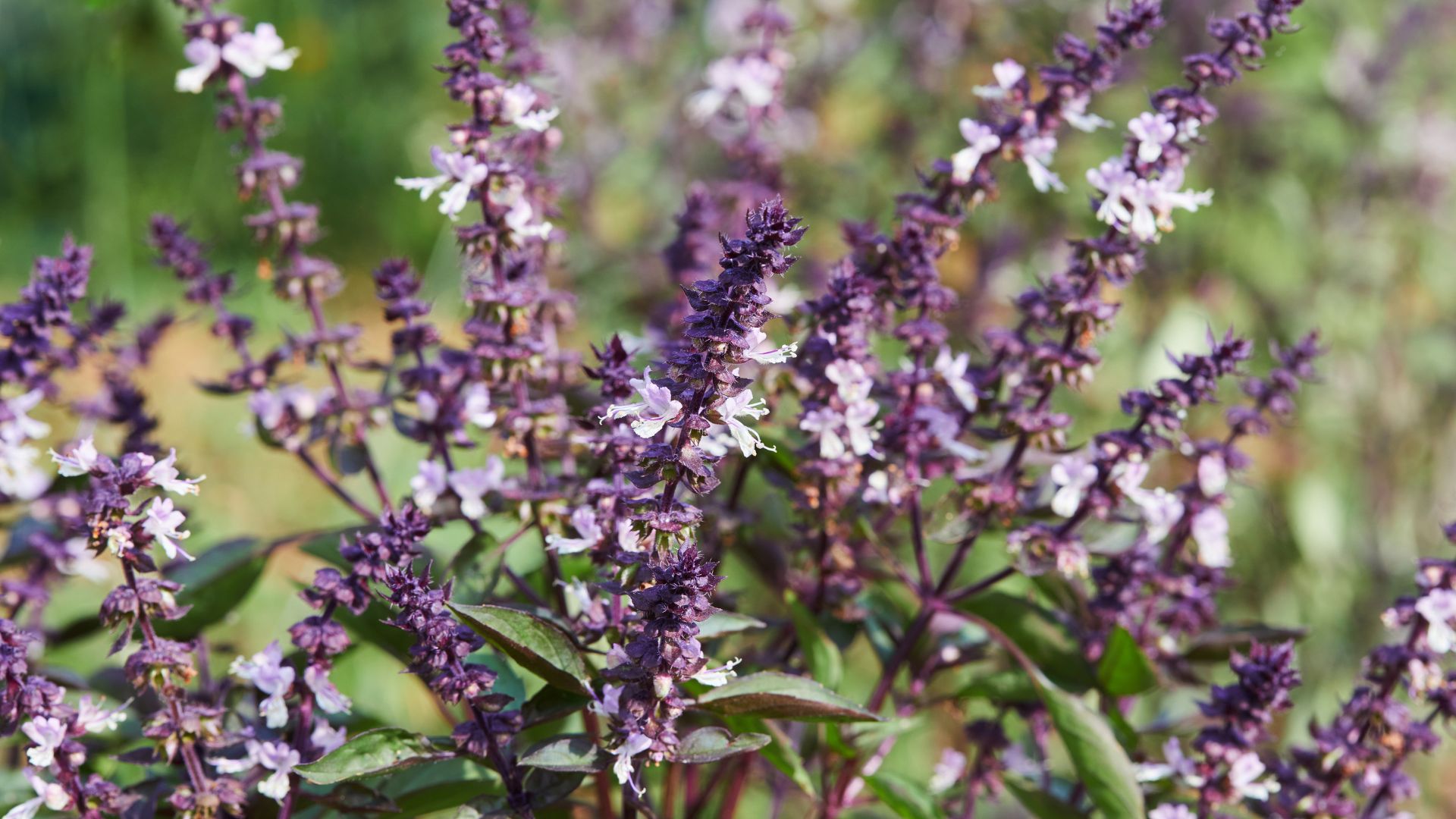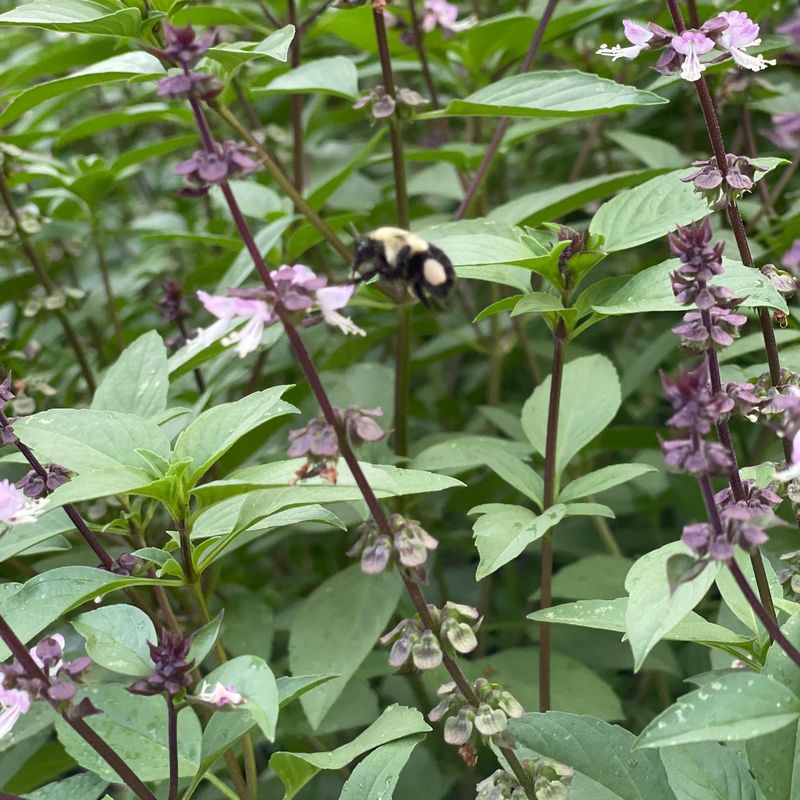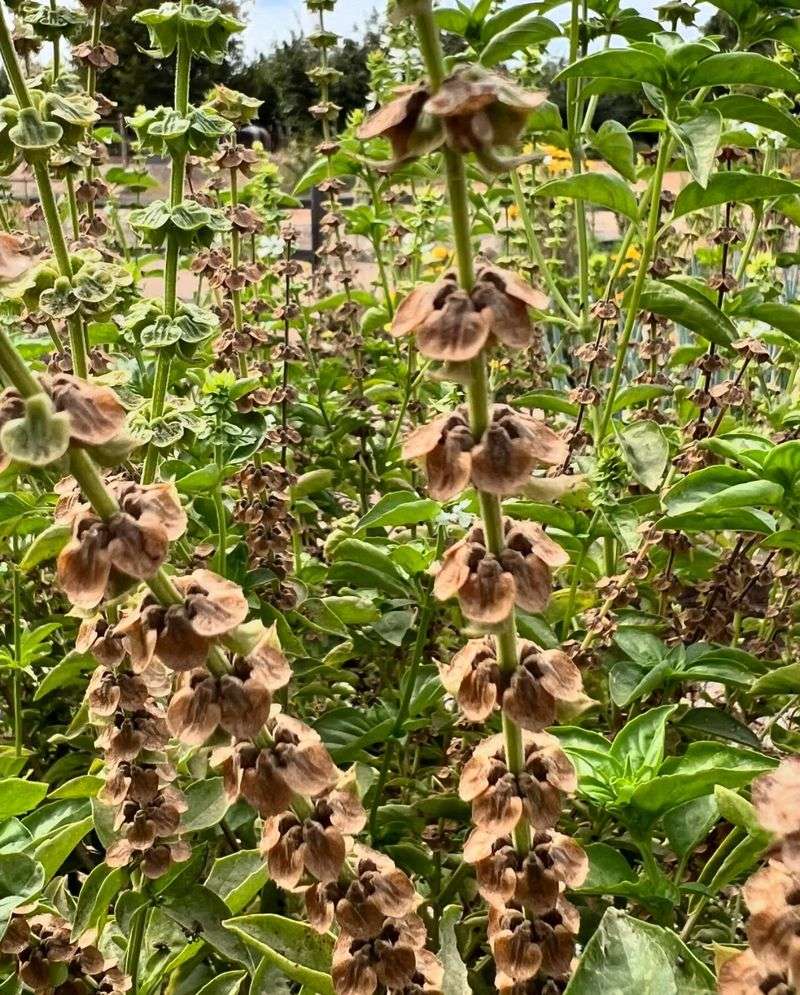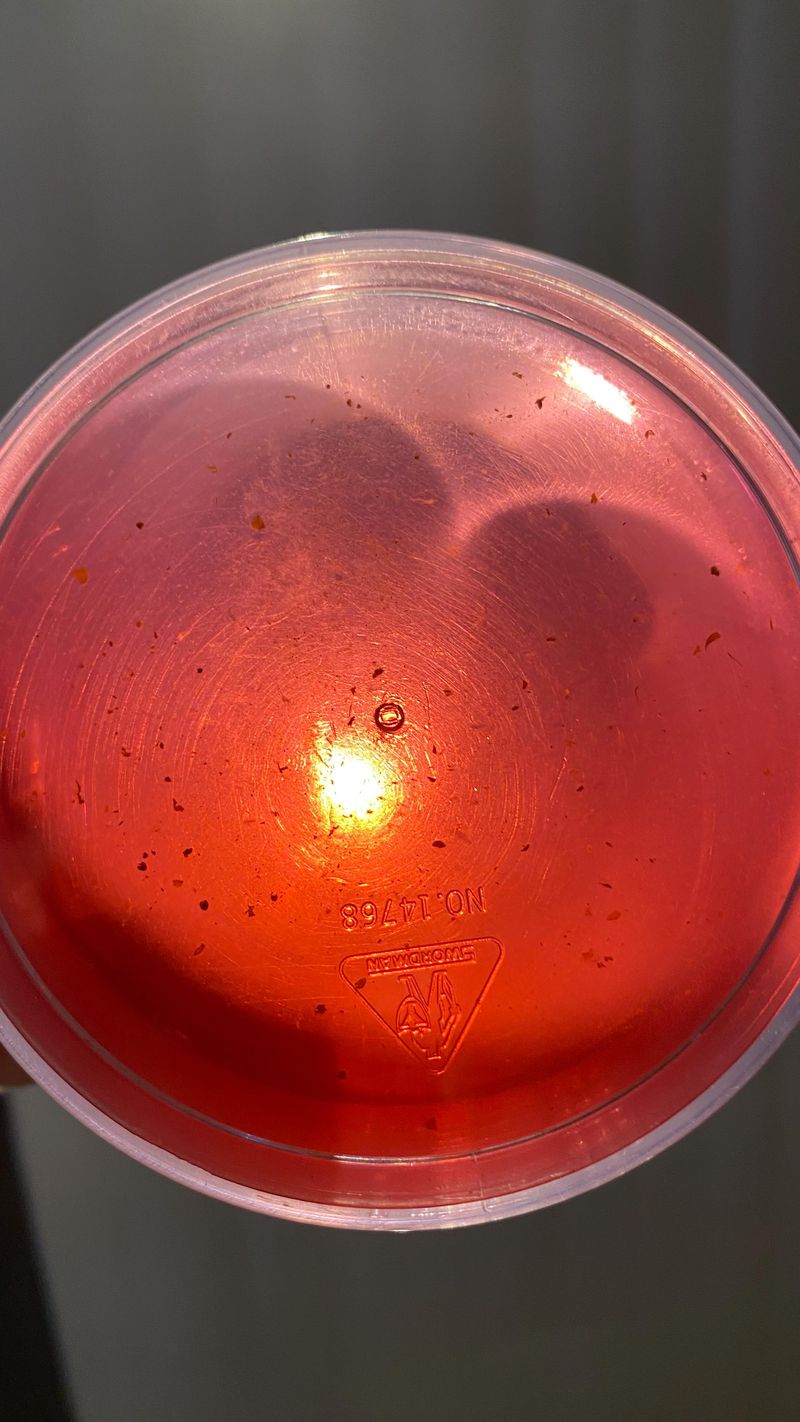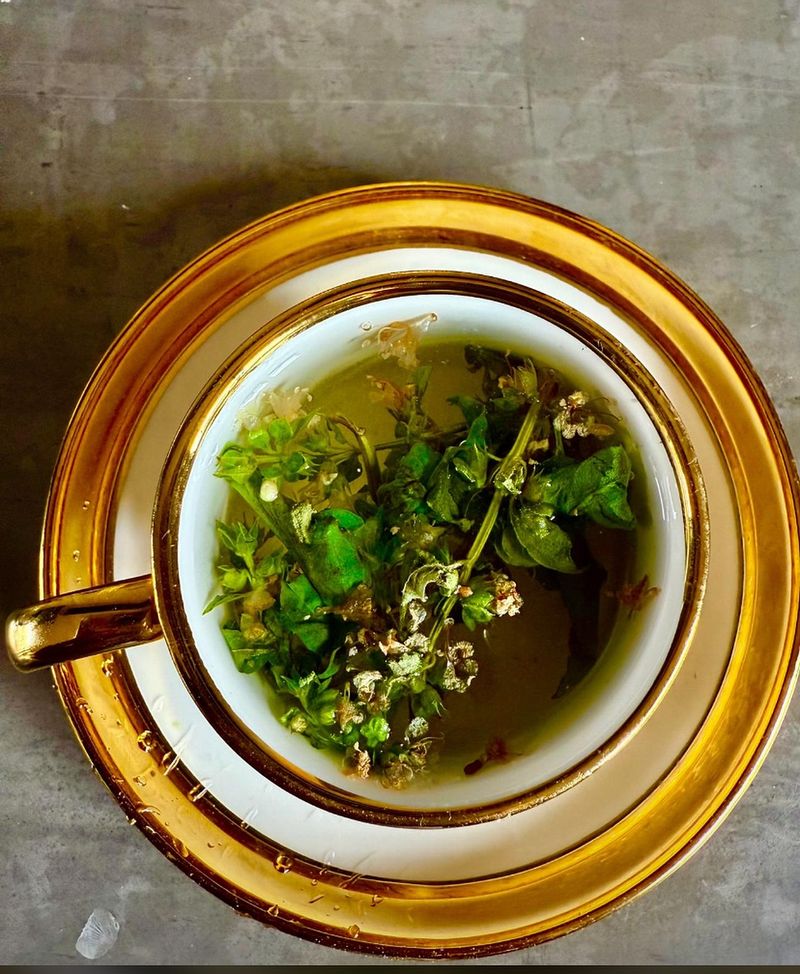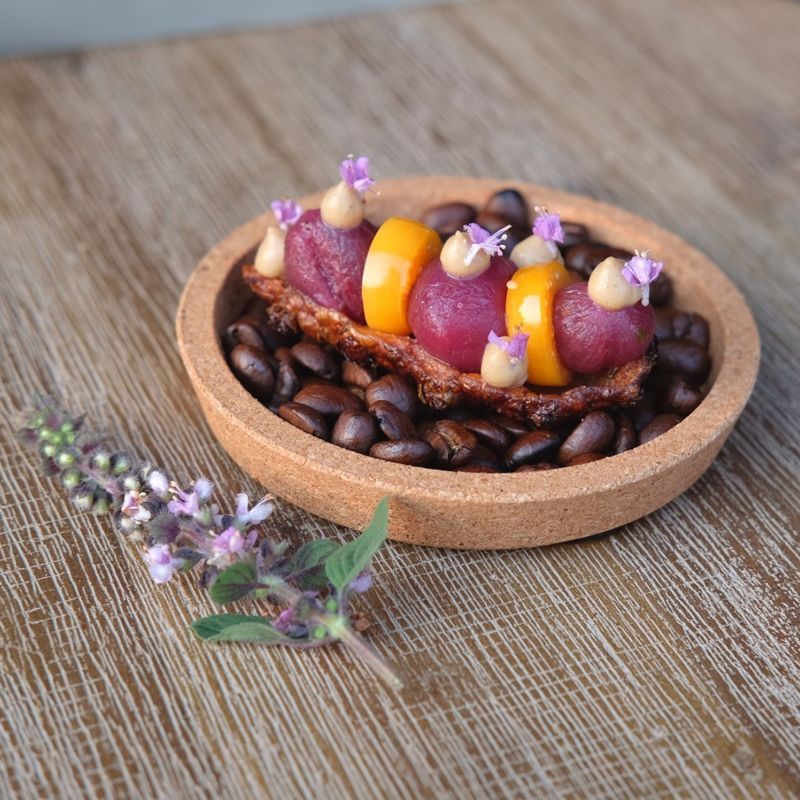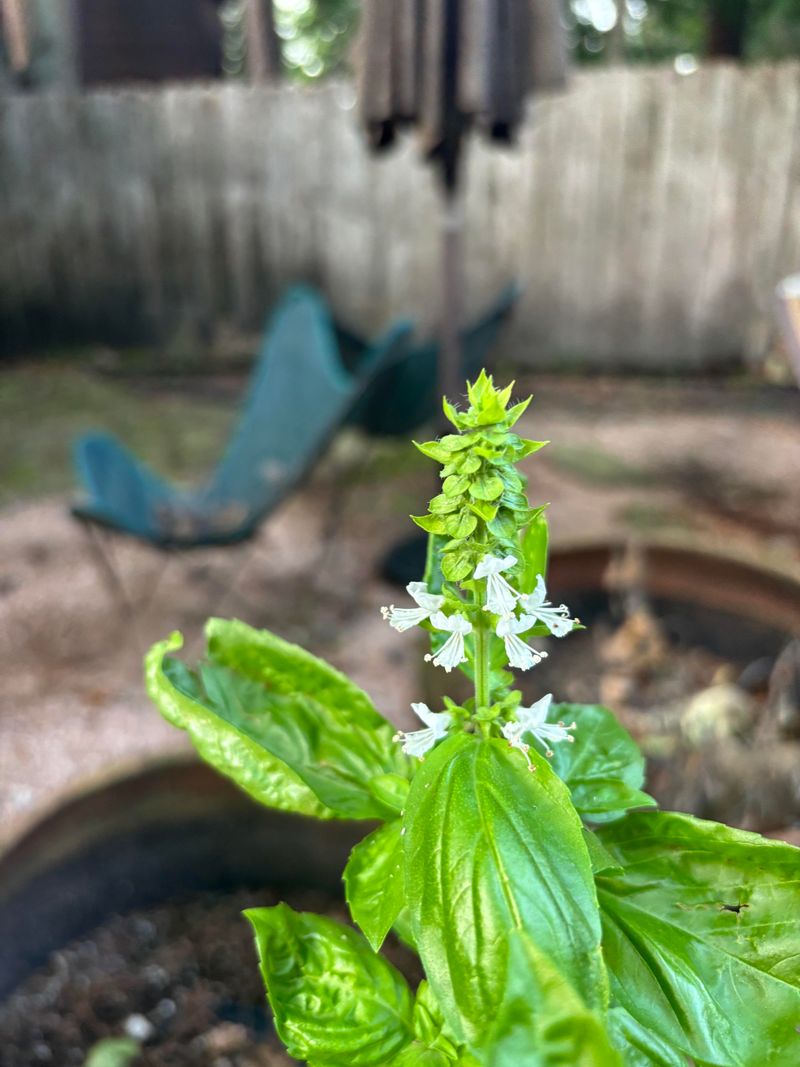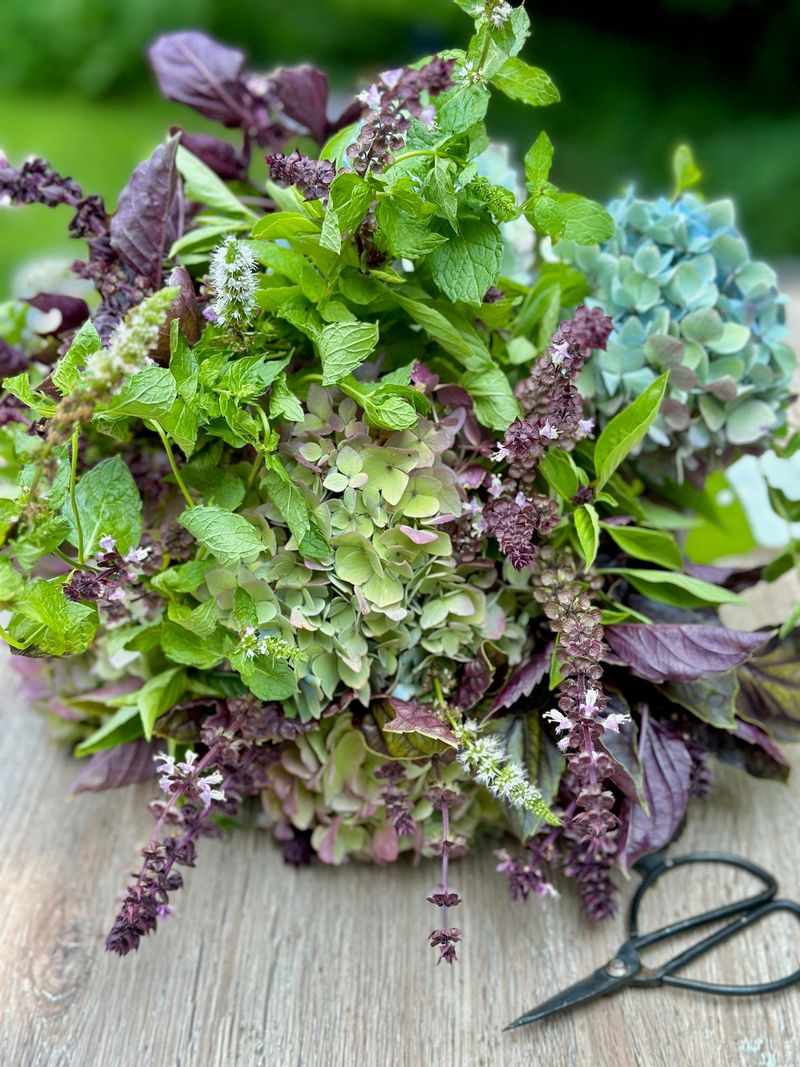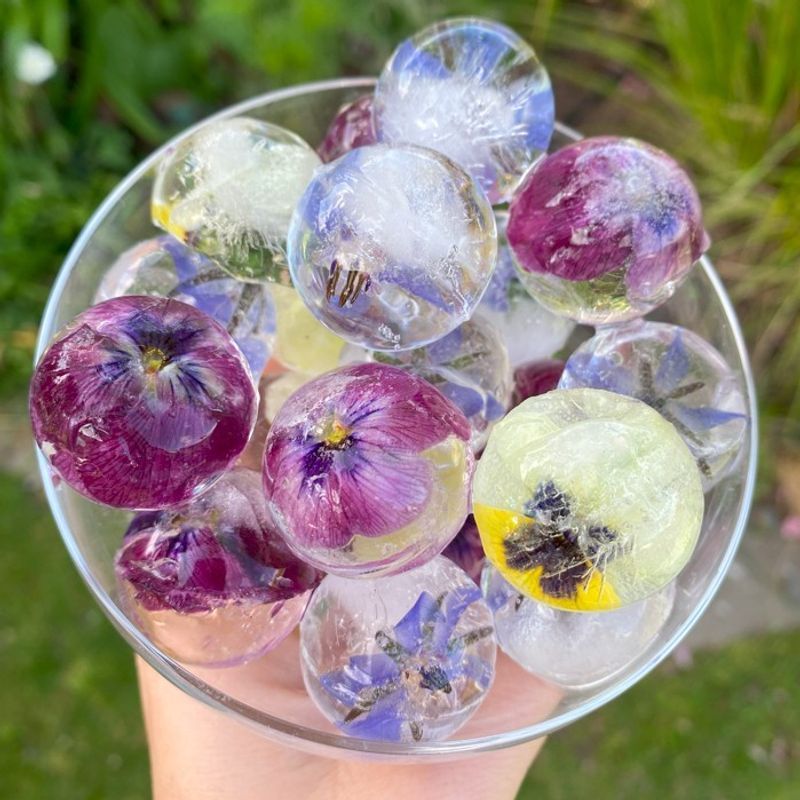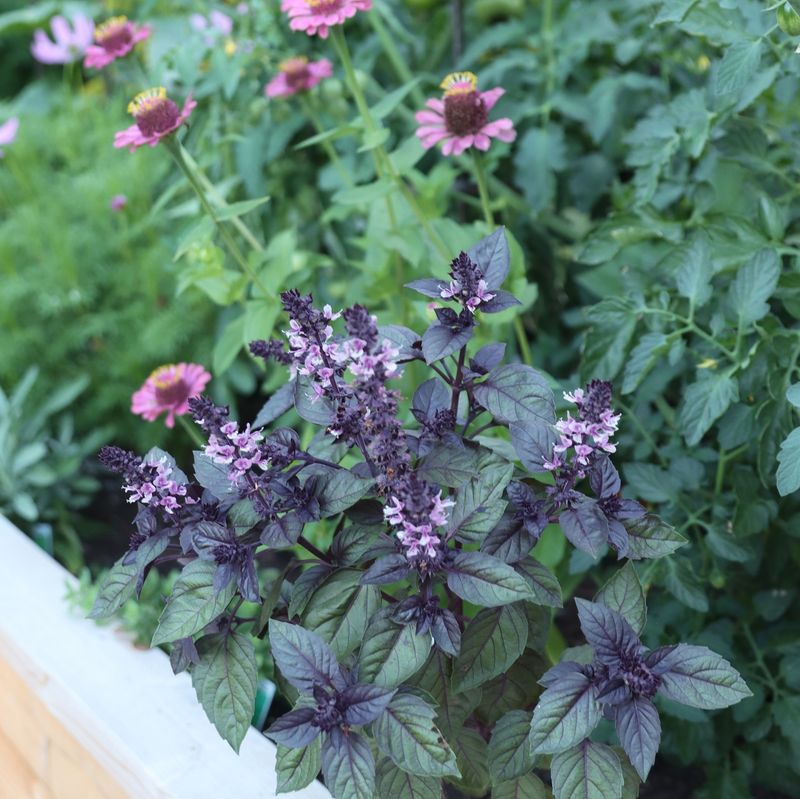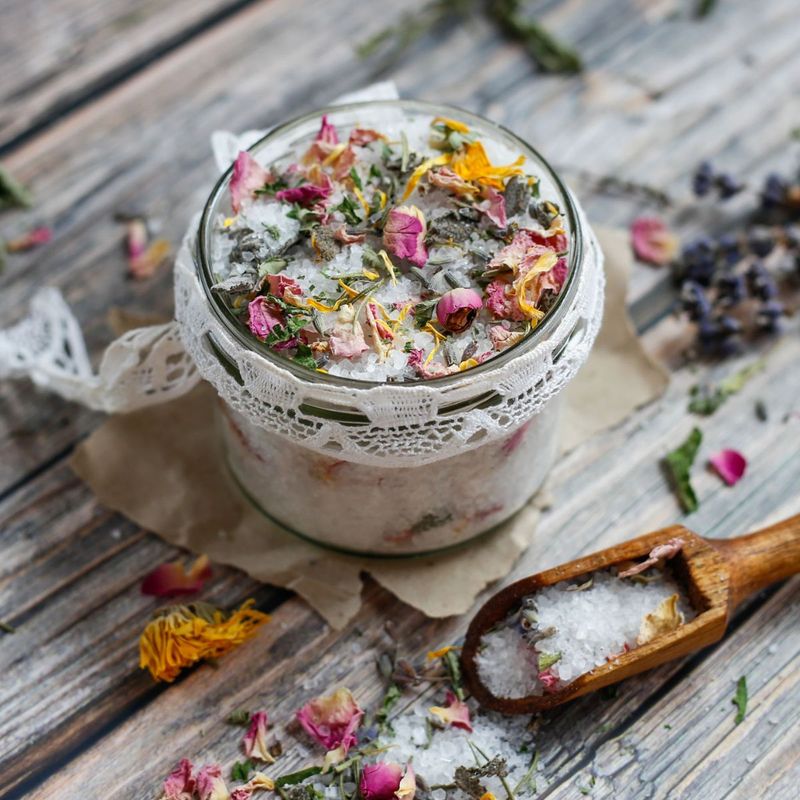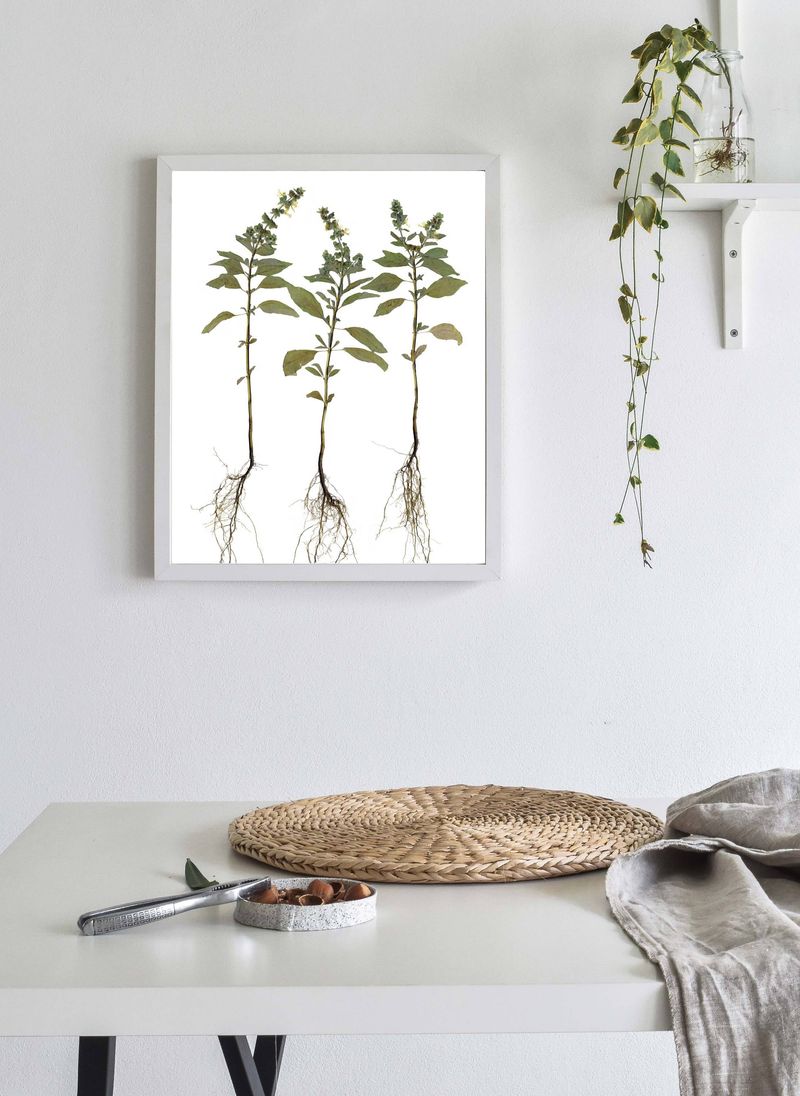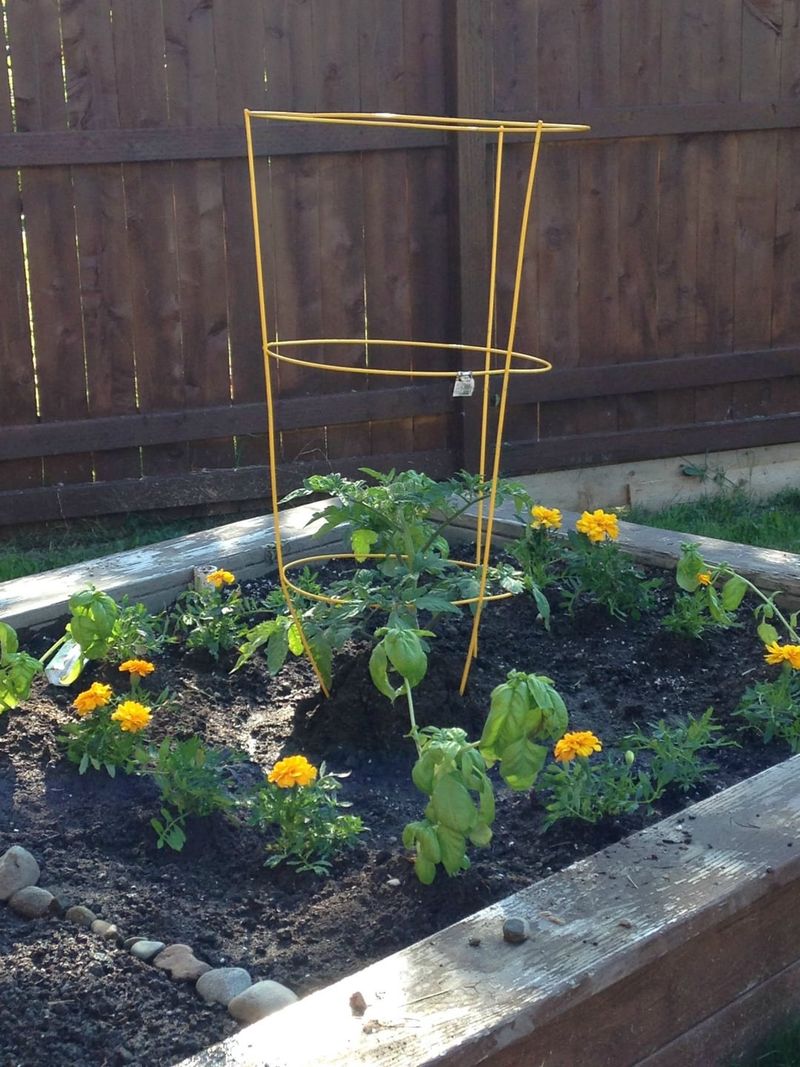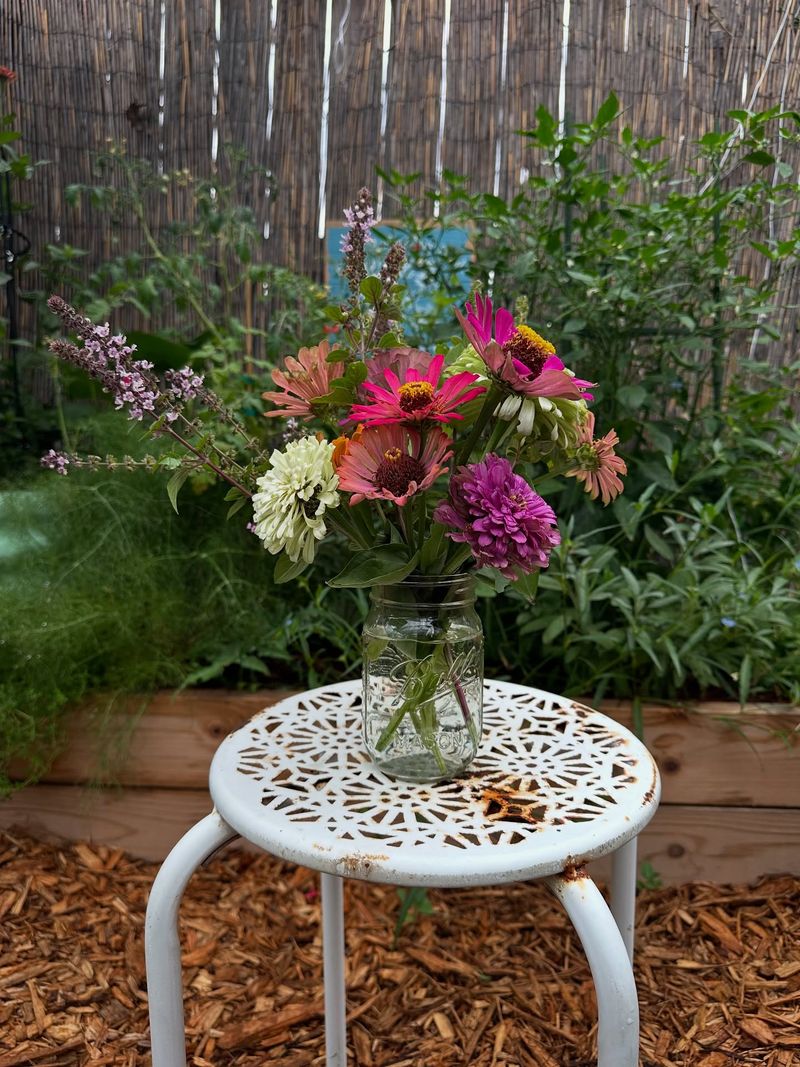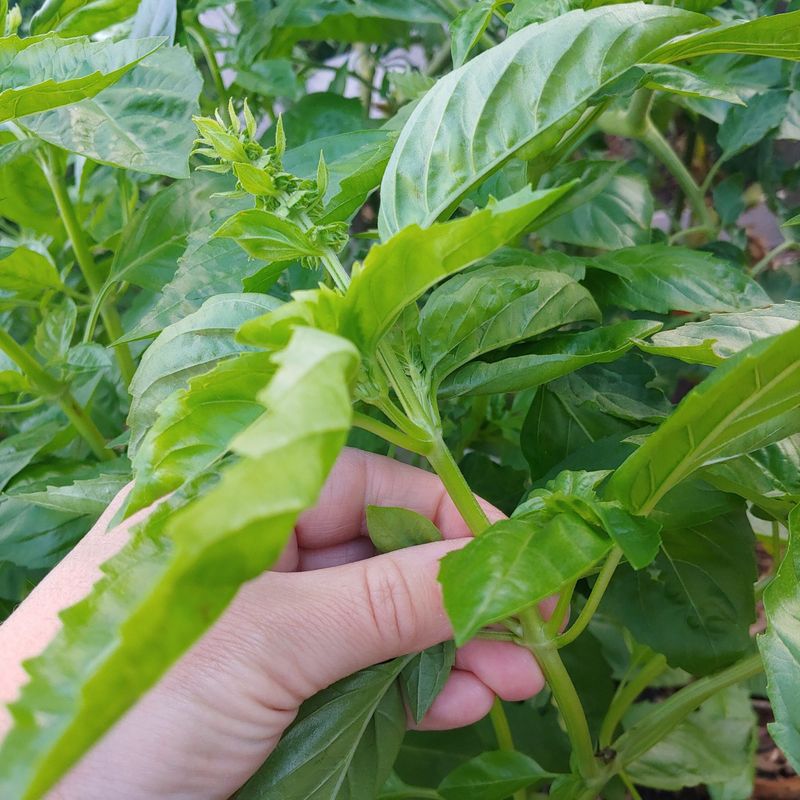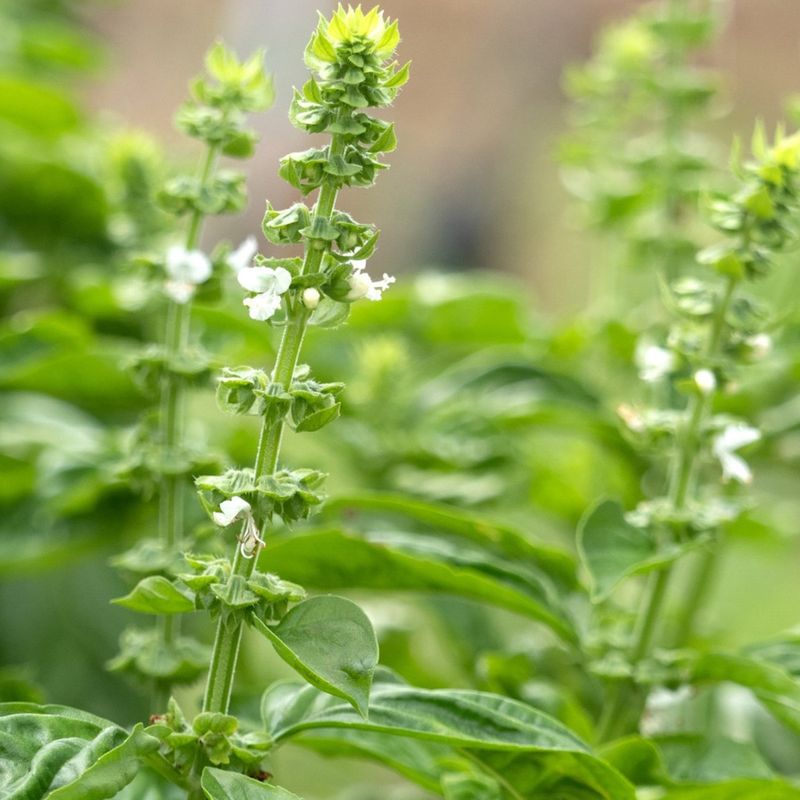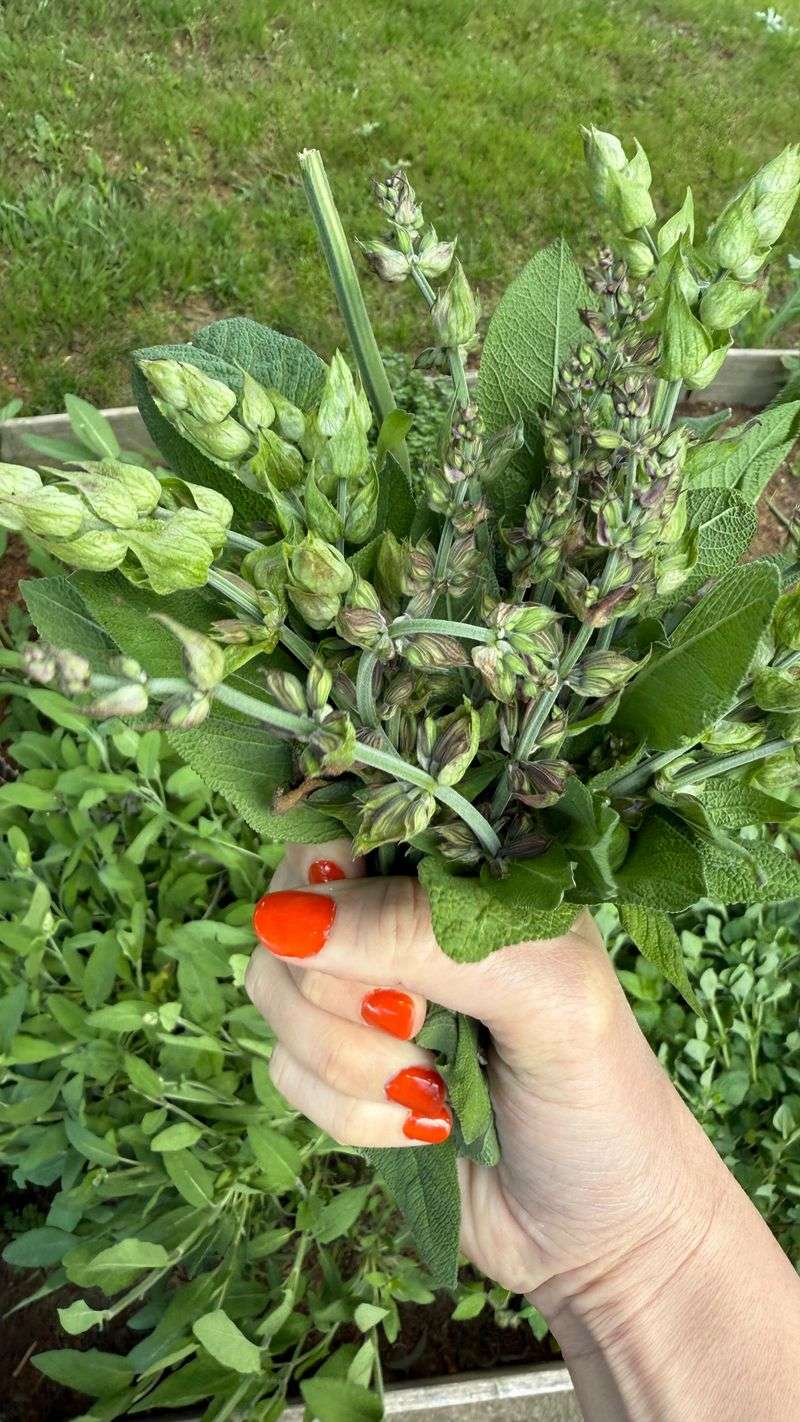When those tiny flower buds pop up on your basil plants, your first instinct might be to pinch them off—especially if you’ve read that blooming makes the leaves bitter. I used to do that automatically, not even thinking twice. But over time, I learned there’s more to basil flowers than meets the eye.
Those delicate little blooms are actually edible and carry a subtle, floral version of that classic basil flavor. I’ve sprinkled them on salads, tucked them into ice cubes for garden parties, and even used them as charming garnishes on pasta dishes. They’re a small detail, but they add a lot of character.
Of course, there are times when you’ll want to snip them off—especially if you’re trying to keep your plant focused on leaf production. But if your basil is getting leggy or nearing the end of the season, letting it bloom a little can be a sweet way to enjoy its final flourish.
1. Pollinator Paradise
Bees absolutely adore these tiny purple-white blossoms! I’ve watched my garden transform into a buzzing metropolis once my basil starts flowering. The nectar-rich blooms attract not just honeybees but also native pollinators that might otherwise skip your garden.
Having these beneficial insects visit means better pollination for your other vegetables and flowers. My tomato yields noticeably improved after I started leaving some basil plants to flower nearby.
The relationship works both ways – you help sustain local pollinator populations while they help your garden thrive. It’s a small act of ecological kindness that creates ripples throughout your growing space.
2. Seed Saving Success
Those flowers eventually develop into seed pods containing next year’s crop! I started collecting these tiny black specks three seasons ago and haven’t bought basil seeds since. The process couldn’t be simpler – just wait until the blooms dry on the stem.
Saving your own seeds means plants that gradually adapt to your specific growing conditions. My second-generation saved basil handled our unusual spring cold snap much better than store-bought varieties.
One plant can produce hundreds of seeds, enough to share with neighbors or trade at seed swaps. Simply store them in a paper envelope in a cool, dry place, and they’ll remain viable for about five years.
3. Flavor-Infused Vinegars
The delicate floral notes transform ordinary vinegar into something extraordinary! Unlike leaf-infused versions, bloom-infused vinegars carry subtle honey undertones that elevate any salad dressing. My dinner guests always ask about the secret ingredient.
Creating your own is surprisingly simple. Pack a clean jar with fresh basil flowers, cover completely with white wine vinegar, and let sit in a cool dark place for two weeks. The resulting amber liquid adds complexity to marinades and quick pickles too.
For gift-giving, I add a fresh sprig with flowers to the bottle before sealing. The visual appeal matches the unique flavor profile, making a thoughtful homemade present that showcases your garden’s bounty.
4. Gentle Floral Teas
Fresh or dried, these blossoms make a surprisingly calming herbal infusion! The flavor profile differs noticeably from leaf-based tea – gentler, with subtle minty-anise notes and a natural sweetness I never expected. My evening ritual now includes this soothing brew.
Harvest blooms in the morning when their essential oils peak. For fresh tea, steep 2 tablespoons in hot (not boiling) water for 5 minutes. The delicate purple flowers create a visually appealing pale amber liquid.
Drying extends your enjoyment beyond the growing season. Simply hang small bunches upside down in a well-ventilated area away from direct sunlight. Once completely dry, store in airtight containers for up to 6 months.
5. Edible Garnish Glory
Tiny blooms transform ordinary dishes into restaurant-worthy presentations! Their mild flavor and beautiful appearance make them perfect for finishing touches on soups, salads, and desserts. I scattered some over chocolate mousse last weekend and watched guests’ eyes widen with delight.
Unlike aggressive herbs, these delicate flowers won’t overwhelm other flavors. They pair particularly well with tomato dishes, lending subtle complexity rather than dominating the palate.
For maximum visual impact, harvest just before serving. The freshest flowers maintain their shape and color best. Try floating them on cold summer soups or pressing into soft cheeses for an elegant appetizer that showcases your garden’s bounty.
6. Natural Confetti Alternative
Dried petals make eco-friendly, biodegradable celebration tossers! Unlike commercial confetti that lingers as litter, these natural bits return to the earth. I first tried this at my sister’s garden wedding – guests loved the subtle fragrance released when tossed.
The drying process preserves much of their purple-white coloration. Simply spread blooms on paper towels in a single layer, then air dry for several days until completely crisp. Store in paper bags until your celebration.
Beyond weddings, they work beautifully for baby showers, anniversary parties, or any outdoor gathering. As a thoughtful touch, include a note explaining their garden origin and eco-friendly nature – your guests will appreciate both the sentiment and sustainability.
7. Fragrant Homemade Sachets
Dried blooms retain their delightful scent for months! Unlike commercial air fresheners with artificial fragrances, these natural sachets provide subtle herbal notes that gently perfume drawers and closets. My linen cabinet has never smelled more inviting.
Creating them couldn’t be simpler. Collect flowers at their peak, dry thoroughly, then fill small cotton pouches or repurposed tea bags. For enhanced fragrance, add a drop of complementary essential oil like lavender or citrus.
These make thoughtful housewarming or hostess gifts when paired with a handwritten note explaining their garden origin. The natural moth-repellent properties offer practical benefits beyond just pleasant scent – protection for woolens without harsh chemicals.
8. Botanical Ice Cubes
Frozen in water, these tiny blooms create conversation-starting drink enhancers! Their delicate appearance suspended in ice adds unexpected elegance to everything from lemonade to cocktails. My summer entertaining took on new sophistication with these simple additions.
The trick is using distilled water for crystal clarity. Fill ice trays halfway, add flowers face down, freeze, then top off with more water and freeze completely. The two-stage process ensures blooms stay centered rather than floating to the top.
Beyond beverages, these decorative cubes can chill fruit soups or be floated in punch bowls. For special occasions, I make larger versions using muffin tins or small bowls – the dramatic presentation always earns compliments from guests.
9. Beneficial Bug Buffet
Flowering basil attracts predatory insects that hunt garden pests! I noticed a marked decrease in aphid problems after allowing some plants to bloom. The tiny wasps and lacewings drawn to these flowers are actually working as your unpaid garden security team.
Unlike chemical solutions, this natural approach strengthens your garden’s ecosystem. The beneficial insects establish themselves, providing ongoing protection rather than temporary relief. My squash plants particularly benefited from this arrangement.
Strategic placement maximizes effectiveness – I plant basil near vegetables that frequently face pest challenges. The flowers serve as refueling stations for the good bugs between hunting trips. This biological balance reduces the need for interventions while improving overall garden health.
10. Herbal Bath Blends
Steeped in hot water, these blossoms release soothing aromatic compounds! Unlike commercial bath products with synthetic fragrances, this natural soak offers authentic garden-to-tub luxury. My evening ritual now includes this simple indulgence after gardening days.
Creating a bath blend requires minimal effort. Fill a muslin bag with dried flowers, tie securely, then hang from the faucet as water fills the tub. The gentle fragrance and natural oils disperse throughout the water.
For enhanced benefits, combine with complementary herbs like lavender or chamomile. The resulting bath not only smells heavenly but also soothes tired muscles and skin irritations. After especially long gardening sessions, this natural remedy helps me recover and prepare for the next day’s work.
11. Pressed Flower Crafting
Flattened between book pages, these tiny blooms create lasting botanical art! Their delicate structure and purple hue retain surprising vibrancy when properly preserved. My handmade greeting cards featuring these pressed treasures always receive compliments.
The pressing process is straightforward but requires patience. Place blooms between absorbent paper in a heavy book for 2-3 weeks. Once completely flat and dry, they’re ready for creative projects like bookmarks, framed displays, or candle decorations.
Documenting the year’s garden becomes possible through these preserved specimens. I label each creation with the variety and season, creating a beautiful botanical timeline. Children especially enjoy this activity, connecting them with plants while developing crafting skills and patience.
12. Companion Planting Strategy
Flowering basil works as a natural trap crop for certain pests! Japanese beetles, in particular, often prefer these blooms over your prized vegetables. I discovered this accidentally when beetles clustered on my flowering basil instead of attacking nearby roses.
This strategic sacrifice protects more valuable plants while concentrating pests for easier removal. Each morning, I simply shake the beetles from the basil into soapy water, significantly reducing their population without chemicals.
The approach works best when basil plants are positioned at the garden’s perimeter. This creates a protective barrier that intercepts flying pests before they reach your main crops. For maximum effectiveness, stagger plantings so some basil is always in bloom throughout the growing season.
13. Flavor-Infused Honey
Steeping these blossoms in raw honey creates a uniquely aromatic sweetener! The process captures delicate floral notes that plain basil leaves simply can’t provide. My morning tea ritual transformed once I started using this infused treat.
Creating your own requires minimal effort but delivers impressive results. Simply layer fresh, clean flowers in a jar, cover completely with raw honey, and let infuse for two weeks. Gentle warming helps the honey absorb more flavor.
Beyond beverages, this botanical honey elevates cheese plates, yogurt parfaits, and salad dressings. I’ve even drizzled it over grilled peaches for a sophisticated summer dessert that showcases the garden’s bounty. Gift jars always disappear quickly at holiday exchanges!
14. Unique Floral Arrangements
Fresh flowering stems add unexpected texture and fragrance to bouquets! Their vertical structure and clustered blooms create visual interest among traditional cut flowers. My dining table centerpieces gained new dimension once I started incorporating these garden volunteers.
Unlike many cut flowers, these stems continue to open new blooms in water, extending the arrangement’s beauty. The subtle fragrance perfumes the room without overwhelming other scents. For maximum vase life, harvest early morning when stems are fully hydrated.
Pairing possibilities are endless – they complement everything from zinnias to roses. I particularly love them with wildflowers for a meadow-inspired arrangement. The purple-white blossoms bridge color gaps between other flowers, creating cohesive displays from diverse garden pickings.
15. Remove For Maximum Leaf Production
Flowering signals the plant’s shift from leaf growth to seed production. Once those little buds appear, energy redirects from the flavorful leaves you’ve been harvesting. I learned this lesson the hard way when my neglected plants developed woody stems and diminished leaf output.
For cooking purposes, prompt removal maintains the plant’s bushy habit and tender leaves. Regular pinching encourages lateral branching, essentially creating two new growing points where there was one. My kitchen supply remains steady with this simple maintenance routine.
This practice particularly matters for container plants with limited resources. In garden settings, consider designating specific plants for blooming while maintaining others strictly for leaf harvest. This balanced approach satisfies both culinary needs and the ecological benefits of flowering.
16. Skip Saving From Stressed Plants
Struggling plants often flower prematurely as a survival response. These panic-produced blooms typically yield poor-quality seeds and less viable offspring. I once collected seeds from drought-stressed plants only to grow disappointing, weak seedlings the following year.
Signs of stress include yellowing leaves, stunted growth, or pest damage alongside flowering. These indicators suggest the plant is rushing to reproduce before dying rather than flowering at its peak genetic potential.
For seed saving purposes, select only from your healthiest, most vigorous specimens. This selective approach ensures you’re preserving desirable traits for future generations. Removing flowers from stressed plants allows them to redirect energy toward recovery instead of reproduction – sometimes enabling a surprising comeback.
17. Avoid When Bitter Flavors Develop
Flowering triggers chemical changes throughout the entire plant. These natural compounds can introduce bitter notes to previously sweet leaves. My culinary disappointment was real when I used post-flowering leaves in pesto only to detect an unexpected sharpness.
Taste-testing confirms this transformation – compare a leaf from a flowering stem with one from a regularly pinched plant. The difference becomes immediately apparent, especially in raw applications like salads or garnishes.
For gourmet purposes, maintain dedicated plants that never flower. This disciplined approach ensures consistent flavor profiles for your signature dishes. When plants do begin flowering, consider transitioning them to pollinator support roles rather than culinary duty – a practical division of garden labor.

